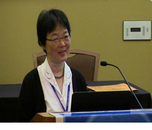Day 2 :
Keynote Forum
Kirankumar S. Mysore
Professor The Samuel Roberts Noble Foundation, USA
Keynote: Insertion Mutagenesis of Medicago truncatula and its Utilization to Identify Novel Sources of Resistance against Asian Soybean Rust
Time : 9:30-10:15

Biography:
KIRAN MYSORE is a Professor at the Noble Research Institute. He joined the Noble in 2002. He also holds Adjunct Professorship at the Department of Entomology and Plant Pathology, Oklahoma State University. He received his Bachelor’s degree in Agriculture at the University of Agricultural Sciences, Bangalore (India), Master’s degree in Horticulture at Clemson University and Ph. D. in Genetics at Purdue University in 1999. He did his postdoctoral training at the Boyce Thompson Institute for Plant Research, Cornell University. His main research interests center on molecular plant-microbe interactions. Research approaches in his group include genetics and genomics to better understand how plants defend against pathogens. In addition, he has developed genetic resources (Tnt1 insertion lines) in Medicago truncatula that is now widely used by the legume community. He has published over 150 papers and book chapters in international journals
Abstract:
Retrotransposons, retrovirus-like elements which encode proteins required for their own replication and transposition, can be used for insertional mutagenesis. Retrotransposons can be activated by tissue culture and preferentially insert in gene-rich regions of the genome. The absence of excision during transposition makes retrotransposons ideal for saturation mutagenesis with stable tags. Tobacco retrotransposon, Tnt1, has been used to mutagenize and tag the whole genome of a model legume, Medicago truncatula. Tnt1 is very active and transpose into, on average, 25 different locations during M. truncatula tissue culture. Mutations induced by Tnt1 insertion are stable during seed to seed generation. We have generated over 20,000 independent Tnt1-containing lines encompassing approximately 500,000 insertion events. Over 300,000 Tnt1 flanking sequence tags (FSTs) have been recovered and a database has been established. We have pooled genomic DNA from all the lines for customized reverse-genetic screening, and the frequency of insert identification in this pool for average-sized-gene is approximately 85% percent. The range and diversity of mutant phenotypes obtained to date suggest that M. truncatula offers a great opportunity to dissect symbiotic and developmental pathways for comprehensive understanding of legume biology. A forward genetics approach using Tnt1 tagged M. truncatula lines has been established (Fig. 1) to identify genes that confer nonhost resistance to Asian Soybean Rust pathogen, Phakopsora pachyrhizi. Several M. truncatula Tnt1 mutants with altered response to P. pachyrhizi have been identified and being characterized. irg1 (inhibitor of rust germ-tube differentation1) mutant inhibited pre-infection structure differentiation of P. pachyrhizi and several other biotrophic pathogens. IRG1 encodes a Cys(2)His(2) zinc finger transcription factor, PALM1 that also controls dissected leaf morphology in M. truncatula. Characterization of other mutants will also be presented.
Keynote Forum
Parwinder Kaur,
The University of Western Australia, Australia
Keynote: Advanced reference genome of Trifolium subterraneum L. reveals loci governing important agronomictraits for biotechnological improvement of forage legumes
Time : 10:15-11:00

Biography:
for Plant Genetics and Breeding (PGB) at the University of Western Australia. Dr Kaur has received the Science and Innovation Award for young people in Agriculture, Fisheries and Forestry in 2013 and produced the world first genome scaffold for subterranean clover using the de-novo sequencing pipelines anchored to a high resolution genetic map and BioNano optical maps for trait mapping. She has been working with a team of researchers across various disciplines to develop methodologies to enable breeders to identify environmentally friendly pasture legume to tackle future challenges for Australian livestock industries
Abstract:
Subterranean clover is an important annual forage legume, whose diploidy and inbreeding nature make it an ideal model for genomic analysis in Trifolium. We reported a draft genome assembly of the subterranean clover TSUd_r1.1. Here we evaluate genome mapping on nanochannel arrays and generation of a transcriptome atlas across tissues to advance the assembly and gene annotation. Using a BioNano-based assembly spanning 512 Mb (93% genome coverage), we validated the draft assembly, anchored unplaced contigs and resolved misassemblies. Multiple contigs (264) from the draft assembly coalesced into 97 super-scaffolds (43% of genome). Sequences longer than >1 Mb increased from 40 to 189 Mb giving 1.4-fold increase in N50 with total genome in pseudomolecules improved from 73 to 80%. The advanced assembly was re-annotated using transcriptome atlas data to contain 31,272 protein-coding genes capturing >96% of the gene content. Functional characterisation and GO enrichment confirmed gene expression for response to water deprivation, flavonoid biosynthesis, and embryo development ending in seed dormancy, reflecting adaptation to the harsh Mediterranean environment. Comparative analyses across Papilionoideae identified 24,893 Trifolium-specific and 6,325 subterranean-clover-specific genes that could be mined further for traits such as geocarpy and grazing tolerance. Eight key traits, including persistence, improved livestock health by isoflavonoid production in addition to important agro-morphological traits, were fine-mapped on the high density SNP linkage map anchored to the assembly. This new genomic information is crucial to identify loci governing traits allowing marker-assisted breeding, comparative mapping and identification of tissue-specific gene promoters for biotechnological improvement of forage legumes.
- Exihibitor
Session Introduction
Raquel Sánchez-Pérez
University of Copenhagen, Denmark
Title: Transcriptomics towards flowering in fruit trees
Biography:
Raquel Sánchez Pérez´s research topic is the study of important agronomic traits within Prunus species, with a desired practical output both for food production and farmer economy. Her research is focused on flowering time and the origin of bitterness in sweet cherry and almond, respectively. The final aim is to develop molecular markers for application in breeding programs that will help to obtain new improved cultivars that are more resistant to the negative effects of climate change. In the last years, she has supervised three PhD theses on secondary metabolites, i.e. cyanogenic glucosides, in flower bud dormancy, seed germination and fruit development. She is further teaching Biochemistry at Copenhagen University, where she is employed and funded by the Villum Foundation, under the Young Investigator Program.
Abstract:
Statement of the Problem: Global warming is threatening the production of more than 40 million tons of stone fruit from the Prunus genus (e.g. cherry, almond, apricot, peach, etc.). The main reason for this is the decrease in the winter chill which is necessary for the flowering process. Hence, the ability to control dormancy release and flowering in perennial plants is extremely desirable.
In the past, different cyanide-based products e.g. hydrogen cyanamide (Dormex®, AlzChem, Germany) have been used in agriculture to compensate for missing winter chill and to advance flowering, suggesting cyanide as a key player in dormancy release. Interestingly, cyanogenic glucosides, which constitute one component in an ancient plant defense system, are also known to release cyanide. The cyanogenic glucoside prunasin is present in flower buds of Prunus plants. Cyanide-based inhibition of antioxidant enzymes like catalase leads to increasing ROS levels, which are known to be important messengers in various cellular processes, like seed germination, a process related to bud dormancy release. Therefore, the purpose of this study is to show how Dormex® is advancing flowering time in fruit tree species like cherry.Methodology: Dormant sweet cherry flower buds were treated with Dormex® and water as a control, sampling flower buds at different time points up to 18 days after treatment. The effects of Dormex® were assessed using RNA sequencing, metabolite profiling and enzyme assays.Findings: Transcriptome analysis revealed more than 6000 Dormex®-responsive genes, among them jasmonate (JA)-, cytokinin-, ethylene- and hydrogen cyanide-associated transcripts. These results were supported on the metabolite level, where a significant increase in JA-Ile and different cytokinins was observed.
Conclusion & Significance: These results suggest a complex mechanism of action for hydrogen cyanamide-induced endodormancy release in sweet cherry.
- Plant Genomics| Plant Breeding | Plant Science | Plant Biotechnology | Plant Genomics Applications | Plant Genome Sequencing
Location: 1

Chair
Kirankumar S. Mysore
Professor The Samuel Roberts Noble Foundation USA

Co-Chair
Arron H Carter
Washington State University, USA
Session Introduction
Joohyun Lee
University of Massachusetts Amherst, USA
Title: Upstream regulatory mechanisms of a cold-induced epigenetic switch in plants
Time : 11:05-11:35

Biography:
Joohyun Lee Present works as a Research Assistant Professor Biology Department, University of Massachusetts Amherst
Abstract:
Proper timing of the flowering transition in plants is a key developmental process necessary for adaptation to various ecological niches. Many plant species require exposure to the prolonged cold of winter to flower, a temperature-sensing process referred to as vernalization. In Arabidopsis thaliana, prolonged exposure to cold epigenetically represses the expression of a floral repressor, FLOWERING LOCUS C (FLC). This cold-mediated repression occurs through an evolutionarily conserved Polycomb repressive complex 2 (PRC2) associated with the vernalization-unique protein VERNALIZATION INSENSITIVE 3 (VIN3) and long noncoding RNAs (lncRNAs) complementary to FLC. The vernalization-specific PRC2 complex results in increased deposition of an epigenetic silencing mark H3K27me3 at FLC chromatin. However, the system by which cold perception leads to the induction of vernalization-specific factors involved in FLC targeting is largely unknown. In this study, we describe the first example of a vernalization-hypersensitive mutant in which the period of cold exposure required to saturate the vernalization response is shortened. This is also the first example of a potential upstream regulator of VIN3 and lncRNAs complementary to FLC. The causative locus encodes a methyltransferase, SET DOMAIN GROUP7 (SDG7), that is required for proper timing of expression of vernalization specific factors in cold-induced polycomb silencing (1). In summary, our work is an important contribution to the understanding of how environmental signals result in epigenetic gene silencing.
Raquel Sánchez-Pérez
University of Copenhagen , Denmark
Title: Transcriptomics towards flowering in fruit trees
Time : 11:35-12:05

Biography:
Raquel Sánchez Pérez´s research topic is the study of important agronomic traits within Prunus species, with a desired practical output both for food production and farmer economy. Her research is focused on flowering time and the origin of bitterness in sweet cherry and almond, respectively. The final aim is to develop molecular markers for application in breeding programs that will help to obtain new improved cultivars that are more resistant to the negative effects of climate change. In the last years, she has supervised three PhD theses on secondary metabolites, i.e. cyanogenic glucosides, in flower bud dormancy, seed germination and fruit development. She is further teaching Biochemistry at Copenhagen University, where she is employed and funded by the Villum Foundation, under the Young Investigator Program
Abstract:
Statement of the Problem: Global warming is threatening the production of more than 40 million tons of stone fruit from the Prunus genus (e.g. cherry, almond, apricot, peach, etc.). The main reason for this is the decrease in the winter chill which is necessary for the flowering process. Hence, the ability to control dormancy release and flowering in perennial plants is extremely desirable.In the past, different cyanide-based products e.g. hydrogen cyanamide (Dormex®, AlzChem, Germany) have been used in agriculture to compensate for missing winter chill and to advance flowering, suggesting cyanide as a key player in dormancy release. Interestingly, cyanogenic glucosides, which constitute one component in an ancient plant defense system, are also known to release cyanide. The cyanogenic glucoside prunasin is present in flower buds of Prunus plants. Cyanide-based inhibition of antioxidant enzymes like catalase leads to increasing ROS levels, which are known to be important messengers in various cellular processes, like seed germination, a process related to bud dormancy release. Therefore, the purpose of this study is to show how Dormex® is advancing flowering time in fruit tree species like cherry.Methodology: Dormant sweet cherry flower buds were treated with Dormex® and water as a control, sampling flower buds at different time points up to 18 days after treatment. The effects of Dormex® were assessed using RNA sequencing, metabolite profiling and enzyme assays.
Weerachai Phutdhawong
Kasetsart University, Thailand
Title: Synthesis and preliminary evaluation of brassinosteroid derivatives for plant growth regulators
Time : 12:05-12:35

Biography:
Weerachai Phutdhawong is an Associate Professor of Organic Chem. at Kasetsart University at Kamphaengsaen, Thailand. He obtained BS from Prince of Songkla University, Thailand and MS and PhD from Chiang Mai University in Thailand and Post-doc (Natural Products Chemistry) at NIES in Japan. His research interest has two main intersecting themes. The first involves the development of methods for the synthesis of novel bioactive compounds and the study of their spectroscopic, chemical and pharmacological properties. Mechanistic aspects of these and associated syntheses are also of interest. New synthetic methods for antibiotic compounds are also being investigated.
Abstract:
Brassinosteroid (BRs) are unusual steroids with a lactone B-ring structure and a dihydroxylate side chain. These steroids have been isolated from many plant species and have been recognized as hormones potentially affecting a wide range of physiological responses in plants, including stem elongation, pollen tube growth, leaf bending and epinasty, root growth inhibition, induced synthesis of ethylene, activation of proton pump, xylem differentiation, synthesis of nucleic acids and proteins, activation of enzymes, and photosynthesis. The brassinolide a C28 brassinosteroid has been reported to be the most biologically active of the BRs and widely studied for applications due to their potential agricultural utility. 28-Homobrassinolide and 28-homocastasterone, the most active C29 BRs have also been intensively investigated for their potential agricultural uses. As BRs are present in plants only in very small quantities, chemical synthesis of BRs is the source for scientific and practical use. This results in numerous synthetic efforts and development of non-natural analogues of BRs that are easier to prepare and which have similar or even greater activity than the natural BRs. In this article, the 28-homocastasterone (3), and analogues including their dimeric compounds were prepared from stigmasterol via a key intermediate olefin. Evaluation of the rice lamina inclination bioassay of the synthesized compounds showed they have lower bioactivity than 28-homocastasterone. However, the novel molecules can be further investigated for other properties, such as persistence, and the results give design considerations for molecules with structures recognized by brassinosteroid receptors.
Fahimeh Shahinnia
IPK, Germany
Title: Improvement of biomass and stress tolerance in crop plants using cyanobacteria flavodi-iron proteins (FDPs)
Time : 13:35-14:05

Biography:
engineering the strategies aimed at improving stress tolerance in barley with emphasizing on genome-editing and overexpression of plant-endogenous genes belonging to different molecular networks for stress responses. Her research interests are: cereal structural and comparative genomics, map-based cloning, QTL mapping, marker assisted breeding, genetics and genomics of drought tolerance, genome-editing and systems biology in barley and wheat..
Abstract:
Environmental stresses and nutrient limitation are among the major causes for crop losses worldwide. Engineering strategies aimed at improving growth and stress tolerance have mostly focused on overexpression of plant-endogenous genes belonging to molecular networks for stress perception or stress responses. A new alternative approach has recently been applied with considerable success to model plants. It is based on the replacement of stress-sensitive plant targets such as ferredoxin by stress-resistant cyanobacterial flavodoxin. The expression of cyanobacterial flavodoxin in chloroplasts in transgenic tobacco plants led to tolerance to various stresses including drought and iron starvation, thus representing a biotechnological application for the generation of crops tolerant to multiple stresses. In the present study, we have tested additional cyanobacterial proteins, flavodi-iron proteins (FDPs), for further investigation of this approach. FDPs are widely distributed among bacteria, archaea and cyanobacteria and show various properties such as dioxygen-scavenging reductase and nitric oxide-scavenging reductase activity indicating a response to oxidative stress superior to that of flavodoxin. In Cyanobacteria, FDPs are encoded by four different genes Flv1, Flv2, Flv3 and Flv4 and function in tandem. Further, FDPs are a sub-class of redox-active proteins containing Fe in a form that does not occur in higher plant proteins. We have introduced the Flv genes in the genome of the plant species Arabidopsis, tobacco and barley to identify the underlying molecular and biochemical mechanisms for their protective action against oxidative stress and to identify the environmental and nutrient conditions, under which Flv-mediated stress tolerance allows for biomass and yield enhancement.
Rachel Swee-Suak Ko
Academia Sinica, Agricultural Biotechnology Research, Taiwan
Title: Manipulation of a bHLH transcription factor to generate male sterility line in rice
Time : 14:05-14:35

Biography:
Rachel SS Ko devotes herself in functional genomics studies in rice and orchid. She identified a key bHLH transcription factor in rice that is essential in rice pollen development. She is interested to carry out detail study on the molecular mechanism underlying pollen development to improve agriculture application of male sterility line for hybrid rice yield improvement.
Abstract:
Hybrid rice is a promising strategy to increase grain yield by 15-20%. Stable male sterility line is important for pure F1 hybrid seed production. We identified a male-sterile TRIM mutant without pollen development in rice. Southern blot indicated that this mutant is single T-DNA insertion even. Heterozygous mutant is fertile and homozygous line is male sterile. Our genetic analyses confirmed that the male sterility in this mutant is controlled by a single recessive locus. Knockout mutant cannot enter meiosis, defects in tapetal programmed cell death and hypertrophy tapetal cells, consequently lead to no pollen development. To know more about the molecular function of bHLH142, we overexpressed bHLH142. Surprisingly, OE lines also showed male sterility. OE caused premature onset of tapetal PCD, defective in ROS scavenging in the anther. Altered expression of several key regulatory transcription factors such as UDT1, GAMYB, TDR1, and EAT1 were found upregulated in OE anther. Our detail molecular study demonstrated that bHLH142 and TDR1 form protein-protein interaction and co-modulate transactivation of EAT1. Either knockout or OE of bHLH142 both lead to defect or premature PCD, eventually all turn out to be sterile. Indicating that homeostatic and tightly control of bHLH142 expression is essential for normal pollen development. This study provides a new method to generate genic male sterility in rice and possibly in other cereal crops too. Moreover, exploitation of this novel functionality of bHLH142 would confer a big advantage to hybrid seed production
Raj Kumar Joshi
Siksha O Anusandhan University, India.
Title: Non-coding RNAs: the master regulators of immunity against phytopathogens
Time : 14:35-15:05

Biography:
Raj Kumar Joshi is Assistant Professor at the Centre of Biotechnology, Siksha O Anusandhan University, India where he teaches graduate level courses on Plant Genomics and Genetic engineering. He also serves as Group Leader of the Centre’s Plant Functional Genomics Group, and in that capacity he supervises the overall research activities on the functional aspects of non-coding RNAs during plant-microbe interactions. He has initiated a collaborative research with Prof. Nat Kav from University of Alberta, Canada to explore the functional role of long non coding RNAs in the anti-fungal networks of B. napus. Dr. Joshi is a life member of the Society of Plant Biochemistry/Biotechnology and the Association of Biological Chemists in India
Abstract:
The whole genome tilling and RNA-Seq analysis has revealed that pervasive transcription is a widespread feature of all eukaryotic genomes. Recent evidences indicate that a significant portion of this unannotated transcripts called the ‘dark matter’ are actually non-coding RNAs with important role in a wide range of biological processes. However, the repertoire and functions of ncRNAs (microRNAs and long non-coding RNAs) largely remains unexplored with respect to defense against phytopathogens. To investigate their role in disease resistance, we have used next generation sequencing approaches to identify ncRNAs responsive to necrotrophic fungi in multiple plant-microbe interactions. A stranded RNA-Seq has resulted in 3181 lncRNAs responsive to Sclerotinia sclerotiorum infection in Brassica napus. A reciprocal expression pattern of the sense/antisense transcript pairs suggested steric clashes of transcriptional machinery and lncRNA mediated inactivation of sense promoter during pathogen attack. Functional characterization of these lncRNAs using RNAi knock-down lines demonstrated their possible role in immunity of canola against Sclerotinia sclerotiorum. Another study on small RNA-seq analysis has resulted in forty-six microRNAs responsive to Fusarium basal rot infection in Allium sativum. Overexpression of a selective set of miRNAs in transgenic garlic plants revealed enhanced resistance to FOC through up-regulated expression of defense-responsive genes and decreased fungal growth. These results indicate that multiple ncRNAs are involved in plant immunity and are critical elements in the defense network of plants against pathogenic fungi
Clive Lo
Associate Professor at The University of Hong Kong
Title: Distinct biosynthesis pathways for flavone C-glycosides and O-glycosides in rice
Time : 15:25-16:00

Biography:
Clive Lo received his PhD at Purdue University. He is currently an Associate Professor at The University of Hong Kong. His laboratory has been working on the biosynthesis pathways of flavonoids in the cereal crops rice and sorghum. They have recently identified a number of phylogenetically conserved enzymes for biosynthesis of flavones which are prevalent in vegetative tissues of grasses. They represent good targets to engineer flavones in edible tissues which do not normally synthesize these health-beneficial phytochemicals
Abstract:
Flavones are flavonoids found extensively in land plants with important physiological functions like UV protection, interactions with other organisms, co-pigmentation in flowers, etc. They are increasingly popular as dietary constituents or supplements due to their health-beneficial properties. In grasses, flavones are predominantly accumulated as C- or O-linked conjugates in vegetative tissues. The enzymology of flavone biosynthesis in monocot remained largely elusive until recent years. Our recent work established the cytochrome P450 enzymes CYP93G1 and CYP93G2 as key branch point enzymes in rice channeling flavanones to the formation of flavone O-linked conjugates and C-glycosides, respectively. CYP93G1 functions as a flavone synthase II, which generates flavone aglycones for different O-linked modifications. On the other hand, CYP93G2 is a flavanone 2-hydroxylase, which produces 2-hydroxyflavanones for immediate C-glycosylation, followed by the formation of the flavone nucleus. We further filled the remaining gap in the tricin biosynthesis pathway with CYP75B4. In tricin, the 3’, 5’-dimethoxyflavone nucleus is formed before O-linked conjugations. CYP75B4 functions as a unique flavonoid 5’-hydroxylase that converts chrysoeriol to selgin, the immediate precursor of tricin. In addition, transgenic expression of CYP93G2 and CYP75B4 in Arabidopsis resulted in accumulation of different tricin O-glycosides which are not normally present in the mustard family. CYP93G1, CYP93G2, and CYP75B4 homologous sequences are unique but highly conserved in Poaceae, suggesting that they are specifically recruited for the biosynthesis of different flavone-derived metabolites that are prevalent in many grass species today.
Chee-Keng Teh
Sime Plantation R&D Centre, Malaysia
Title: The path from genomic discovery to commercial planting in oil palm
Time : 16:00-16:30

Biography:
Chee-Keng Teh holds a position of Chief Molecular Breeder II in Biotechnology and Breeding Department, Sime Darby Plantation R&D Centre. He has his expertise in quantitative genetics, development genetic tools and prediction models to maximize genetic gains in oil palm breeding. He and a team of multidisciplinary scientists in Sime Darby Plantation started genomic discovery programs since 2009, and has successfully realized transition from the discoveries to commercial planting in 2016. Before 8 years of humble service in Sime Darby Plantation, he completed 2-year MSc program in National University of Malaysia based on his research on genetic diversity of oil palm germplasm supported by Malaysia Palm Oil Board (MPOB). Currently, he is pursuing his PhD degree in University of Nottingham
Abstract:
Statement of the Problem: The objective of oil palm breeding is to produce high-yielding materials. In Southeast Asia, thick-shelled Deli dura (D) and shell-less AVROS pisifera (P) are maintained separately as maternal and paternal pools, respectively. The reciprocal recurrent selection (RRS) of elite parents is based on the performance of thin- shelled tenera progeny derived from DxP crosses. However, large- scale DxP crossing to evaluate every individual of D and P is impossible due to resource constrains. Furthermore, RRS required more than 20 years completing a selection cycle. The snail’s-pace breeding will put the oil palm industry at risk, when the planting materials fail to cope with drastic changes in the environment. The paper will cover the experience of developing genetic tools and prediction models for early selective breeding. The challenges of translating the genomic discoveries to commercial deployment also will be discussed.
Methodology & Theoretical Orientation: Sime Darby Plantation sequenced the oil palm genome in 2009. A 200K-SNP array, OP200K was then developed after quality filters. The array was used for genome-wide association study (GWAS) and followed by genomic selection (GS) to further improve prediction accuracy. To facilitate commercial deployment, a high-throughput pipeline was also developed in house.
Findings: About 6 million SNPs were identified throughout the genome, representing important breeding stocks in the industry. Important QTLs for bunch component and oil yield traits were successfully detected. The QTL profile was used as the basics for GS modeling, which achieved >0.5 of prediction accuracy.
Conclusion & Significance: The density-reduced SNP panel with minimal accuracy trade-off is now available for selecting the best yielding seeds in Sime Darby Plantation. The first 100 ha planting of Genome Select seeds with estimated 16% of yield increment were launched in April 2016. The upscaling of Genome Select seed production is currently taking place
- Agrotechnology | Plant Pathology | Cereals and Crops | Plant Tissue Culture | Plant Stem Cells | Transgenic Plants | Seed Genomic

Chair
Grace Chen
U.S. Department of Agriculture, USA

Co-Chair
Dragan Škorić
Professor University of Novi Sad Serbia
Session Introduction
Peng W. Chee
University of Georgia, USA
Title: Identification of differentially expressed genes: A step closer towards cloning the root-knot nematode resistance genes in Upland cotton
Time : 11:20-11:50

Biography:
present working in a Cotton Molecular Breeding Lab.University of Georgia, USA
Abstract:
The southern root-knot nematode (Meloidogyne incognita; RKN) is one of the most important endoparasitic pests of Upland cotton (Gossypium hirsutum L.). RKN management through host plant resistance is the most economical, practical, and environmentally sound method to provide protection against this pest. High level of nematode resistance found in a germplasm line ‘Auburn 623RNR’ was transferred to line M-120 through backcrossing Auburn 623RNR to an agronomically adapted cultivar C-201. The resistant line M-120 displays a high degree of resistance to both galling and egg production. Prior genetic analysis of line M-120 has identified two epistatically interacting RKN resistance QTLs, qMi-C11 and qMi-C14, affecting gall formation and RKN reproduction, respectively. Root tissues of RKN resistant and susceptible plants infected with nematodes were obtained at two intervals after inoculation for transcriptome sequencing using RNA-seq approach. Preliminary analysis show that over 1400 genes display differential expression (DE) between resistant and susceptible lines. Further functional characterization of DE genes at previously marked QTL intervals will offer clues toward the identification of the causal genes conferring RKN resistance in Upland cotton.
Akira Endo
Institute of Agrobiological Sciences, Japan
Title: Genome editing in plants using small Cas9 and Cpf1
Time : 11:50-12:20

Biography:
Akira Endo is a Post-doctoral Research Fellow at the Plant Genome Engineering Research Unit, National Agriculture and Food Research Organization (NARO). He received his PhD from Tokyo Metropolitan University where he studied about regulatory mechanism of a plant hormone, abscisic acid biosynthesis under drought stress in Arabidopsis using biochemical and immunohistochemical techniques. At NARO, his research has focused on genome editing with CRISPR/Cas9 and CRISPR/Cpf1 systems, and he is currently working on the development of precise genome editing using Cpf1 to create crops with improved agronomical value and increased social acceptance
Abstract:
Cas9 is a RNA-guided endonuclease (RGN) that belongs to CRISPR/Cas system, functioning in an adaptive immune system of bacteria. CRISPR/Cas9 has been intensively developed and applied to genome editing in various organisms. Most widely used Cas9 is from Streptcoccus pyogenes (SpCas9) since it robust genome editing activity. SpCas9 gene is 4.1 kb in size and protein recognizes NGG as protospacer adjacent motif (PAM) which is located just next to target sequence. The size and PAM of SpCas9 could restrict the utilization of virus vector and number of target sequence, respectively. To expand the utility of Cas9 protein in plant genome engineering, we tried to adapt two different RGNs to genome editing in plant. One is Cas9 from Staphylococcus aureus (SaCas9). The feature of SaCas9 is the smallness in size. SpCas9 consists of 1368 amino acids. In contrast, the number of amino acids of SaCas9 is 1053. Therefore, SaCas9 could be mounts on virus vector. The other is the CRISPR from Prevotella and Francisella 1 (Cpf1) which is an emerging RGN. Cpf1 has two distinct properties that distinguish it from Cas9. First, Cpf1 utilizes a thymidine (T)-rich PAM, in contrast to the guanidine (G)-rich PAM preferred by Cas9. Thus, Cpf1 can target T-rich regions that Cas9 hardly access. Second, upon cleavage of the target sequence, Cpf1 produces a staggered (sticky) DNA end with a 5´ overhang while Cas9 generates a blunt DNA end. Sticky DNA ends are thought to be applicable to precise genome engineering via a precise end-joining pathway. To evaluate whether these RGNs can be adapted to plant genome editing, we applied SaCas9 and FnCpf1 to targeted mutagenesis in tobacco and rice. Our results demonstrate that SaCas9 and FnCpf1 can be applied successfully to genome engineering in plants.
Yasinta Ratna E. Wulandari
Atma Jaya Catholic University, Indonesia
Title: An Efficient Regeneration for Micropropagation of Morus spp. Using Axillary Buds
Time : 12:20-12:50

Biography:
Yasinta Ratna Esti Wulandari a lecturer at Faculty of Biotechnology, Atma Jaya Catolic University of Indonesia, and she is currently the head of plant and tissue culture laboratory since 2015. She graduated from Department of Biology (S.Si.) from Bogor Agricultural University; and obtained her M.Si. in Biology from Bogor Agricultural University. During her career, she received a number of academic awards, such as Atma Jaya Seminar Award in 2014 and 2015, and Asian Federation on Biotechnology (AFOB) award in 2015. Yasinta Ratna E. Wulandari is interested in Plant Tissue Culture and Plant Biotechnology. Some of her research are regeneration of Citrus mitis and Citrus reticulata using somatic embryogenesis technique, Mulberry micropropagation using plant growth regulator combination, determination DNJ compound from Mulberry leaves and study gene expression in Oil Palm inoculated with Ganoderma that caused stem basal rot disease
Abstract:
Problem: Morus spp. known as mulberry plant contain many beneficial phytochemical. It has been suggested the multiplication with seed is slow and the root is weaker if stem cutting method is applied. The purpose of this study is to find the best composition medium in shoot induction, elongation, and rooting stage. Materials and Methods: Four mulberry species were used in this research, M. alba var. kanva-2, M. bombycis var. lembang, M. cathayana, and M. multicaulis. Explant used were axillary buds. There are 3 stages of regeneration: shoot induction, elongation and rooting. Shoot induction medium is MS supplemented with Benzyl Adenine (BA) 2.25 mg/L and Naphtalene Acetic Acid (NAA) 0.56 mg/L. Elongation medium is MS supplemented with BA (0.99 mg/L, 1.35 mg/L, 1.98 mg/L) and Indole Butyric Acid (IBA) 0.41mg/L. Rooting medium is ½ MS medium supplemented with IBA 1.02 mg/L and Activated Charcoal (AC) 1%. Data analysis: Analysis of Variance (ANOVA). Findings: M. multicaulis showed the best response in induction stage and showed the highest data in all parameters. In elongation stage, the highest shoot growth was recorded in MS medium supplemented with BA 1.98 mg/L and IBA 0.41 mg/L combination. M. multicaulis show the best response in shoot growth in this stage. In rooting stage, M. cathayana and M. multicaulis showed the significance difference in all parameters. ½ MS medium supplemented with IBA 1.02 mg/L and AC 1% more effective for rooting than control. Conclusion & Significance: M. multicaulis is the best mulberry species which showed the best response in all stages and the best concentration of BA is 1.98 mg/L. Recommendations are made to apply precise amount of hormone concentration and hormone combination to developed the best protocol in mass propagation of Morus spp. and also to support in vitro conservation.
Qiang Wei
Nanjing Forestry University, China
Title: Exploring key cellular processes and candidate genes regulating the primary thickening growth of moso underground shoots
Time : 13:50-14:20

Biography:
Qiang Wei employs a combination of anatomy, mathematics, genomics, genetic, biochemical and other approaches to disclose the molecular mechanisms underlying the distinguished developmental process of bamboo with special interests in the development of bamboo wood.
Abstract:
The primary thickening growth of Moso (Phyllostachys edulis) underground shoots largely determines the culm circumference. However, its developmental mechanisms remain largely unknown. Using an integrated anatomy, mathematics and genomics approach, we systematically studied cellular and molecular mechanisms underlying the growth of Moso underground shoots. We discovered that the growth displayed a spiral pattern and pith played an important role in promoting the primary thickening process of Moso underground shoots and driving the evolution of culms with different sizes among different bamboo species. Different with model plants, the shoot apical meristem (SAM) of Moso is composed of six layers of cells. Comparative transcriptome analysis identified a large number of genes related to the vascular tissue formation that were significantly unregulated in a thick wall variant with narrow pith cavity, mildly spiral growth, and flat and enlarged SAM, including those related to plant hormones and those involved in cell wall development. These results provide a systematic perspective on the primary thickening growth of Moso underground shoots, and support a plausible mechanism resulting in the narrow pith cavity, weak spiral growth but increased vascular bundle of the thick wall Moso.
Ahmed Jawaad Afzal
Lahore University of Management Sciences (LUMS), Pakistan
Title: The role of NOI-domain containing proteins in modulating PAMP- and Effector- triggered immunity
Time : 14:20-14:50

Biography:
Dr. Ahmed Jawaad Afzal Associate Professor Department Of Biology Lahore University of Management Sciences (LUMS) Plants employ multiple layers of immunity to guard against infection. The first layer responds to structures within conserved microbial molecules. The second layer responds to effector proteins, which are pathogen-encoded virulence factors. These two “branches” of the immune system synergize to provide robust host defense that halts most infections. My current work focuses on understanding the role of the multifunctional protein RIN4, which regulates both branches of the plant immune system.
Abstract:
Plants have developed a multi-layered immune system that allows them to effectively fend off most infections. The first layer termed PAMP triggered immunity (PTI), responds to conserved microbial features while the second layer, known as effector triggered immunity (ETI), restricts bacterial ability to suppress PTI through the introduction of effector proteins into the host cell. In the model organism, Arabidopsis thaliana, the NOI containing protein RIN4 regulates both branches of the immune system. RIN4 negatively regulates PTI and suppresses the ectopic activation of RPS2 which activating an RPS2 dependent hypersensitive response, upon the introduction of the bacterial effector, AvrRpt2.
Suppression of RPS2 activation requires RIN4 to be localized at the membrane via the palmitoylation of terminal cysteine residues while the presence of a conserved motif (VPKFG) in the NOI- domains of RIN4 is required for effector mediated activation of RPS2. In an attempt to find RIN4 like proteins in crop species, we carried out an in silico analysis using AtRIN4 as query. Our analysis revealed that apple, barley, potato, tomato, soybean, peach, rice and lettuce genomes contained RIN4 orthologs with high degree of sequence conservation in both NOI domains. Furthermore, the RIN4 cleavage site (VPKFG) within the NOI domains as well as the C-terminal cysteine residues important for suppressing RPS2 were also highly conserved in the orthologous proteins. On the basis of these findings we hypothesize that these crop species might also employ RIN4-like proteins for the regulation of PAMP and Effector triggered immune responses.
Farhatullah
University of Agriculture Peshawar, Pakistan
Title: Morphological characterization of interploid F6 populations of Brassica
Time : 14:50-15:20

Biography:
Farhatullah is working as Meritorious Professor in the University of Agriculture Peshawar Pakistan. His research is mainly focused on indigenous crops of Khyber Pakhtunkhwa province of Pakistan. He has developed several Brassica lines through interspecific hybridization. He is now working on to find cytological and molecular evidence of inheritance of special characters like double pods and male sterility in advanced generations of brassica interspecific hybrids.
Abstract:
Six parental lines and their 42 F6 populations were evaluated at the University of Agriculture Peshawar during the cropping season 2015-16. Among F6 populations, maximum primary branches (5.4) were recorded for Bnr9F6.Populations Bnr25F6 and Bnr38F6 were early in flowering (78.7 days) maturity (171.4 days), respectively. Tallest plants (144.1cm) and longest pods (9.27 cm) were produced by population Bnr40F6. Longest main raceme (88.7 cm) was recorded for population Bnr3F6, while maximum pods on main raceme (46.7) were recorded for populations Bnr42F6. Maximum seeds pod-1 (21.14) and maximum protein contents (24.2 %) were recorded for population Bnr41F6. Population Bnr14F6 gave maximum 100-seed weight (0.93 g plant-1), while population Bnr41F6 gave high yield plant-1 (30.92 g plant-1). Population Bnr33F6 had maximum oil (54.8%) while low glucosinolate (80.55µmol/g) was recorded for population Bnr36F6. High oleic acid (50.52 %) was recorded for population Bnr13F6, while low erucic acid (49.2%) was recorded for population Bnr30F6. Among F5:6 populations, moderate to high heritability was recorded for all morphological and biochemical traits with high genetic advance. Cluster analysis classified the 42 F5:6 populations along their 6 parental lines into two main groups. Group I consist of 26 populations described for tallest plants (134.66 cm), maximum primary branches (3.94), seeds pod-1 (18.31), high protein (20.27%), high oleic acid (57.02%), longest main raceme (77.55 cm), longest pods (7.82 cm), high yield (19.64 g) and maximum seed weight (0.64 g). Group II consist of 22 populations are categorized for early maturity (171.80 days), minimum glucosinolate (82.96 umol/g), minimum linoleic acid (7.65%) and maximum 100-seed weight (0.83 g). The clustering pattern disclosed that every group had potential attributes for different characters and could be used in future breeding programs for desirable traits. Populations Bnr41F6 is recommended for use in further breeding programs as it had maximum protein, yield plant-1, protein contents and seeds pod-1.
